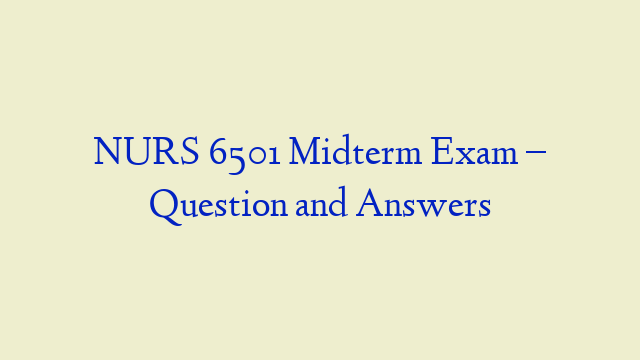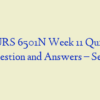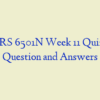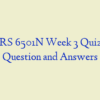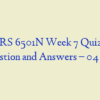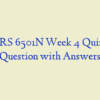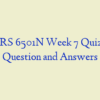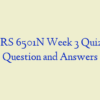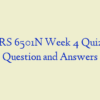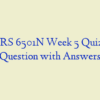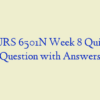Description
NURS 6501 Midterm Exam
1. A nurse recalls asthma is classified by:
2. A 14-year-old male is experiencing an asthma exacerbation. When reviewing the lab results, which of the following cells in the submucosa promote this inflammatory response and will be elevated?
3. If an individual with respiratory difficulty were retaining too much carbon dioxide, which of the following compensatory responses would the nurse expect to be initiated?
4. A 20-year-old male is in acute pain. An arterial blood gas reveals decreased carbon dioxide (CO2) levels. Which of the following does the nurse suspect is the most likely cause?
5. A 20-year-old male presents to his primary care provider reporting difficulty breathing when lying down. What term should the nurse use to document this condition?
6. A 42-year-old male was involved in a motor vehicle accident during which he suffered a severe head injury. He died shortly after the accident from loss of respiration. The nurse suspects the area of the brain most likely involved is the:
7. A 2-week-old female presents with fever, cough, respiratory distress, and empyema. Which of the following is the most likely diagnosis the nurse will observe on the chart?
8. A 28-year-old male reports to his primary care provider that he has had a cold for a week and is coughing up bloody secretions. When giving report, what term should the nurse use to describe this condition?
9. A young patient is admitted to the pediatric unit with cystic fibrosis (CF) exacerbation. The nurse monitors the patient closely because the main cause of death in a child with CF is:
10. A 53-year-old male with a 20-year history of smoking is diagnosed with emphysema. When a staff member asks why the patient’s airways are obstructed, how should the nurse respond? The airways are obstructed because of:
11. A 22-year-old female presents with chronic bronchitis. Tests reveal closure of the airway during expiration. While planning care, a nurse recalls this condition is most likely caused by:
12. An 11-year-old female presents with a low-grade fever and cough. She is diagnosed with atypical pneumonia. What type of pneumonia does the nurse suspect the patient is experiencing?
13. A 65-year-old male recently had a cerebrovascular accident that resulted in dysphagia. He now has aspiration of gastric contents. The nurse assesses the patient for which complication?
14. A 7-month-old male presents with cystic fibrosis (CF) accompanied by failure to thrive and frequent, loose, and oily stools. Sweat testing reveals increased chloride. Which of the following should the nurse observe for that would accompany this disease?
15. When the nurse is asked what causes asthma, how should the nurse respond? Asthma is thought to be caused by:
16. A nurse is preparing to teach the staff about asthma. Which information should the nurse include? Airway obstruction contributing to increased airflow resistance and hypoventilation in asthma is caused by:
17. A 60-year-old female with emphysema is having difficulty expiring a given volume of air. When giving report, the nurse will relay that the patient is most likely experiencing _____ pulmonary disease.
18. A 50-year-old male presents with hypotension, hypoxemia, and tracheal deviation to the left. Tests reveal that the air pressure in the pleural cavity exceeds barometric pressure in the atmosphere. Based on these assessment findings, what does the nurse suspect the patient is experiencing?
19. A 30-year-old female received a severe head injury in a motor vehicle accident. She is now experiencing respiratory abnormalities characterized by alternating periods of deep and shallow breathing with periods of apnea. What term should the nurse use when charting this condition?
20. While reviewing lab results, to help confirm a diagnosis of cystic fibrosis in a 1-year-old child which substance will be present in the child’s sweat?
21. A 25-year-old male presents with chronic bronchitis of 5 months duration. When obtaining the patient’s history, which of the following findings is most likely to cause this condition?
22. A 6-month-old female presents with rhinorrhea, cough, poor feeding, lethargy, and fever. She is diagnosed with bronchiolitis. Which of the following will the nurse most likely observe on the culture report?
23. A 47-year-old male is diagnosed with pulmonary edema. Which assessment findings will the nurse observe?
24. A 10-year-old male is brought to the ER with prolonged bronchospasm and severe hypoxemia. The most likely diagnosis on the chart is:
25. A 42-year-old female presents with dyspnea; rapid, shallow breathing; inspiratory crackles; decreased lung compliance; and hypoxemia. Tests reveal a fulminant form of respiratory failure characterized by acute lung inflammation and diffuse alveolocapillary injury. Which of the following is the most likely diagnosis the nurse will observe on the chart?
26. A 10-year-old female develops pneumonia. A physical exam reveals subcostal and intercostal retractions. She reports that breathing is difficult and she feels she cannot get enough air. What term should the nurse use to document this condition?
27. A newborn has respiratory distress syndrome. When obtaining the patient’s history, which of the following is the most important predisposing factor for this condition?
28. A 50-year-old male with a 30-year history of smoking was diagnosed with lung cancer. He was previously exposed to air pollution, asbestos, and radiation at his job. Which of the following should the nurse realize had the greatest impact on the development of his cancer?
29. Which patient would the nurse assess for paroxysmal nocturnal dyspnea (PND)?
30. When the nurse observes a diagnosis of nosocomial pneumonia, the patient generally acquires this pneumonia:
1. An 80-year-old female develops pneumonia in the hospital. She becomes cyanotic, tachycardic, and develops a fever and cough. Chest x-ray reveals pus in the pleural space. Which of the following is the most likely diagnosis documented on the chart?
2. A 45-year-old male undergoes lung transplantation. He now suffers from airway occlusion secondary to fibrosis. Which diagnosis will the nurse see on the chart?
3. A 20-year-old male presents to his primary care provider reporting difficulty breathing when lying down. What term should the nurse use to document this condition?
4. A nurse is preparing to teach the staff about asthma. Which information should the nurse include? Airway obstruction contributing to increased airflow resistance and hypoventilation in asthma is caused by:
5. When the nurse is asked what causes asthma, how should the nurse respond? Asthma is thought to be caused by:
6. When the pulmonologist discusses the condition in which a series of alveoli in the left lower lobe receive adequate ventilation but do not have adequate perfusion, which statement indicates the nurse understands this condition? When this occurs in a patient it is called:
7. A 9-year-old male contracted influenza. Which of the following complications is of greatest concern to the nurse?
8. A geneticist is discussing cystic fibrosis (CF). Which information should be included? CF is an _____ disease.
9. A 47-year-old male is diagnosed with pulmonary edema. Which assessment findings will the nurse observe?
10. A 2-week-old female presents with fever, cough, respiratory distress, and empyema. Which of the following is the most likely diagnosis the nurse will observe on the chart?
11. A 13-year-old female is diagnosed with asthma. Which of the following should the nurse teach the patient to recognize as part of an asthmatic attack?
12. Individuals with a recent diagnosis of emphysema should be assessed for which most common presenting factor?
13. A 10-year-old female develops pneumonia. Physical exam reveals subcostal and intercostal retractions. She reports that breathing is difficult and she feels she cannot get enough air. What term should the nurse use to document this condition?
14. A 30-year-old female received a severe head injury in a motor vehicle accident. She is now experiencing respiratory abnormalities characterized by alternating periods of deep and shallow breathing with periods of apnea. What term should the nurse use when charting this condition?
15. A 57-year-old male presents with cough, sputum production, dyspnea, and decreased lung volume. He is diagnosed with pneumoconiosis. When taking the patient’s history, which finding is the most probable cause of his illness?
16. Which patient would the nurse assess for paroxysmal nocturnal dyspnea (PND)? A patient with:
17. A 53-year-old male with a 20-year history of smoking is diagnosed with emphysema. When the nurse is asked what causes this, what is the nurse’s best response? Changes in his lungs are caused by:
18. Which of the following shows a correct cause and effect sequence in the development of acute respiratory distress syndrome (ARDS)?
19. A 28-year-old male reports to his primary care provider that he has had a cold for a week and is coughing up bloody secretions. When giving report, what term should the nurse use to describe this condition?
20. A 25-year-old male presents with chronic bronchitis of 5 months’ duration. When obtaining the patient’s history, which of the following findings is most likely to cause this condition?
21. A 42-year-old female presents with dyspnea; rapid, shallow breathing; inspiratory crackles; decreased lung compliance; and hypoxemia. Tests reveal a fulminant form of respiratory failure characterized by acute lung inflammation and diffuse alveolocapillary injury. Which of the following is the most likely diagnosis the nurse will observe on the chart?
22. A 15-year-old female is diagnosed with restrictive lung disease caused by fibrosis. The patient had a pulmonary functions test. Which of the following findings is expected?
23. A young patient is admitted to the pediatric unit with cystic fibrosis (CF) exacerbation. The nurse monitors the patient closely because the main cause of death in a child with CF is:
24. A 60-year-old female with a 25-year history of smoking is diagnosed with emphysema. She has an increased anterior-posterior chest diameter. The nurse attributes this finding to:
25. A 65-year-old male recently had a cerebrovascular accident that resulted in dysphagia. He now has aspiration of gastric contents. The nurse assesses the patient for which complication?
26. A nurse recalls asthma is classified by:
27. A 50-year-old male with a 30-year history of smoking was diagnosed with lung cancer. He was previously exposed to air pollution, asbestos, and radiation at his job. Which of the following should the nurse realize had the greatest impact on the development of his cancer?
28. A 26-year-old female recently underwent surgery and is now experiencing dyspnea, cough, fever, and leukocytosis. Tests reveal that she has a collapsed lung caused by removal of air from obstructed alveoli. What condition will the nurse observe on the chart?
29. A 60-year-old female with emphysema is having difficulty expiring a given volume of air. When giving report, the nurse will relay that the patient is most likely experiencing _____ pulmonary disease.
30. A nurse is reviewing the results of an ABG and finds reduced oxygenation of arterial blood. What term should the nurse use to describe this condition?
Course NURS-6501D-3,Advanced Pathophysiology
1. How are potassium and sodium transported across plasma membranes?
2. The ion transporter that moves Na+ and Ca2+ simultaneously in the same direction is an example of which of the following types of transport?
3. An aide asks the nurse why people who have neurofibromatosis will show varying degrees of the disease. Which genetic principle should the nurse explain to the aide?
4. A cell is isolated, and electrophysiology studies reveal that the resting membrane potential is ?70 millivolts. The predominant intracellular ion is Na+, and the predominant extracellular ion is K+. With voltage change, which of the following would result in an action potential?
5. When a patient asks what causes cystic fibrosis, how should the nurse respond? Cystic fibrosis is caused by an _____ gene.
6. What is the diagnosis of a 13-year-old female who has a karyotype that reveals an absent homologous X chromosome with only a single X chromosome present? Her features include a short stature, widely spaced nipples, reduced carrying angle at the elbow, and sparse body hair.
7. A nurse is reviewing the pedigree chart. When checking for a proband, what is the nurse looking for?
8. The nurse would be correct in identifying the predominant extracellular cation as:
9. A 13-year-old girl has a karyotype that reveals an absent homologous X chromosome with only a single X chromosome present. What medical diagnosis will the nurse observe on the chart?
10. A patient who has diarrhea receives a hypertonic saline solution intravenously to replace the sodium and chloride lost in the stool. What effect will this fluid replacement have on cells?
11. Which of the following mutations have the most significant effect on protein synthesis?
12. Which of the following disorders is manifested primarily in males?
13. The nurse is teaching staff about the most common cause of Down syndrome. What is the nurse describing?
14. A group of prison inmates developed tuberculosis following exposure to an infected inmate. On examination, tissues were soft and granular (like clumped cheese). Which of the following is the most likely cause?
15. Sodium and water accumulation in an injured cell are a direct result of:
16. The student is reviewing functions of the cell. The student would be correct in identifying the primary function of the nerve cell as:
17. 55-year-old male has swelling of the feet. Which of the following aided in development of swelling?
18. A runner has depleted all the oxygen available for muscle energy. Which of the following will facilitate his continued muscle performance?
19. A 55-year-old male with a 30-year history of smoking is examined for respiratory disturbance. Examination of his airway (bronchial) reveals that stratified squamous epithelial cells have replaced the normal columnar ciliated cells. This type of cellular adaptation is called:
20. A newborn male is diagnosed with albinism based on skin, eye, and hair appearance. Which finding will support this diagnosis?
21. The early dilation (swelling) of the cell’s endoplasmic reticulum results in:
22. A patient has a heart attack that leads to progressive cell injury that causes cell death with severe cell swelling and breakdown of organelles. What term would the nurse use to define this process?
23. A 20-year-old pregnant female gives birth to a stillborn child. Autopsy reveals that the fetus has 92 chromosomes. What term may be on the autopsy report to describe this condition?
24. A nurse is teaching a patient with diabetes how glucose is transported from the blood to the cell. What type of transport system should the nurse discuss with the patient?
25. A patient wants to know the risk factors for Down syndrome. What is the nurse’s best response?
1. A 62-year-old male presents to his primary care provider reporting chest pain at rest and with exertion. He does not have a history of coronary artery disease and reports that the pain often occurs at night. He is most likely experiencing which type of angina?
2. When a patient has a massive pulmonary embolism (PE), what complications will the nurse monitor for?
3. Many valvular stenosis and regurgitation disorders in adults have a common etiology. Which of the following conditions should alert the nurse that the patient may have both types of valve dysfunction?
4. A 50-year-old female presents with a low heart rate and low blood pressure. She is given an intravenous (IV) infusion of fluids. The increase in atrial distension results in:
5. A 70-year-old female is in the hospital for pelvic fracture. She develops pulmonary thromboembolism. The nurse realizes this embolus is composed of:
6. A 28-year-old female presents with severe chest pain and shortness of breath. She is diagnosed with pulmonary embolism, which most likely originated from the:
7. A 50-year-old obese male with hypertension and coronary artery disease visits a nutritionist for food counseling. He has an elevated level of low density lipoprotein (LDL) and a low level of high-density lipoprotein (HDL). Which of the following should the nurse advise him to avoid?
8. A 52-year-old male presents with pooling of blood in the veins of the lower extremities and edema. The diagnosis is chronic venous insufficiency, and an expected assessment finding of this disorder is:
9. A 75-year-old female has been critically ill with multiple organ dysfunction syndrome (MODS) for longer than a week and has developed a severe oxygen supply and demand imbalance. The statement that best describes this imbalance is which of the following?
10. A 60-year-old male is diagnosed with cerebral aneurysm. Where does the nurse suspect the cerebral aneurysm is located?
11. A 60-year-old male undergoes surgery for a bone fracture. Which of the following nursing measures would be most effective for preventing pulmonary embolism (PE) in this patient?
12. A 50-year-old male with a 30-year history of smoking was diagnosed with bronchogenic cancer. He developed edema and venous distention in the upper extremities and face. Which of the following diagnosis will the nurse observe on the chart?
13. A 50-year-old male is diagnosed with orthostatic hypotension. Which of the following symptoms would he most likely experience?
14. A 50-year-old male visits the cardiologist for an EKG. Results indicate that he has no PR interval and a variable QRS rate with rhythm irregularity. Which of the following is the most likely diagnosis to be recorded on the chart?
15. A 60-year-old male presents to his primary care provider reporting chest pain. He is diagnosed with atherosclerosis. This disease is caused by:
16. A 65-year-old female presents to the emergency department reporting difficulty swallowing and shortness of breath. A CT scan would most likely reveal an aneurysm in the:
17. While planning care for a patient with superior vena cava syndrome (SVCS), which principle should the nurse remember? SVCS is a progressive _____ of the superior vena cava (SVC) that leads to venous distention of the upper extremities and head.
18. An 80-year-old female is in the hospital for a bone fracture. While there she develops a large, nonlethal pulmonary embolus. Which of the following is a direct result of the obstruction to pulmonary blood flow?
19. Which characteristic changes should the nurse keep in mind while caring for a patient with left heart failure? As left heart failure progresses:
20. What term should the nurse document for a detached blood clot?
21. Which of the following findings in the patient with Raynaud disease would indicate a need for further teaching?
22. A 52-year-old male is diagnosed with primary hypertension. He has no other health problems. Present treatment would cause the nurse to anticipate administering which drug to the patient?
23. A 51-year-old male is at the health clinic for an annual physical exam. After walking from the car to the clinic, he developed substernal pain. He also reported discomfort in his left shoulder and his jaw, lasting 2 to 3 minutes and then subsiding with rest. He indicates that this has occurred frequently over the past few months with similar exertion. The nurse suspects he is most likely experiencing:
24. A 50-year-old female received trauma to the chest that caused severe impairment of the primary pacemaker cells of the heart. Which of the following areas received the greatest damage?
25. A 5-year-old female is found to have hypertension during three separate visits to her primary care provider. The nurse would expect tests to suggest that the hypertension is secondary to:
26. Which condition should cause the nurse to assess for high-output failure in a patient?
27. A 65-year-old male presents for a routine checkup. A blood pressure check reveals a systolic pressure of 160 mm Hg and a diastolic pressure of 70 mm Hg. Which of the following is the most likely cause of this type of pressure elevation?
28. A patient wants to know what causes atherosclerosis. How should the nurse respond? In general, atherosclerosis is caused by:
29. A 32-year-old female presents with lower leg pain, with swelling and redness. While obtaining the patient’s history, which finding could have caused her condition?
30. A 52-year-old female is diagnosed with coronary artery disease. The nurse assesses for myocardial:
1. When histamine is released in the body, which of the following responses would the nurse expect?
2. When a patient asks the nurse what hypersensitivity is, how should the nurse respond? Hypersensitivity is best defined as:
3. A 65-year-old female is diagnosed with metastatic breast cancer. She has developed muscle wasting. Which of the following substances would be produced in large quantities to eliminate the tumor cells and cause muscle wasting?
4. Which of the following individuals would be at greatest risk for an opportunistic infection?
5. A 20-year-old male shoots his hand with a nail gun while replacing roofing shingles. Which of the following cell types would be the first to aid in killing bacteria to prevent infection in his hand?
6. A 35-year-old male is diagnosed with a hormone-secreting tumor of the adrenal medulla. He experiences elevated blood pressure, pupil dilation, “goose bumps,” and increased anxiety. Which of the following hormones is the predominant one released by the tumor?
7. When the maternal immune system becomes sensitized against antigens expressed by the fetus, what type of immune reaction occurs?
8. A 30-year-old male is having difficulty breathing and has been spitting blood. He reports that he began experiencing this reaction after cleaning his pigeons’ cages. Testing reveals he is suffering from allergic alveolitis. Which of the following is he experiencing?
9. A 10-year-old male is stung by a bee while playing in the yard. He begins itching and develops pain, swelling, redness, and respiratory difficulties. He is suffering from:
10. Stress induces sympathetic stimulation of the adrenal medulla. This causes the secretion of catecholamines, which include:
11. Which of the following hormones activates adrenergic receptors?
12. A 10-year-old male presents to his primary care provider reporting wheezing and difficulty breathing. History reveals that both of the child’s parents suffer from allergies. Which of the following terms would be used to classify the child?
13. A 45-year-old male presents with persistent, severe stomach pain. Testing reveals a peptic ulcer. Further laboratory tests reveal the presence of Helicobacter pylori. Which of the following is of concern for this patient?
14. A 3-year-old is making play cakes in a sandbox and is eating the play cakes. The sand was also being used by cats as a litter box and was contaminated with toxoplasmosis. Which of the following would most likely also be present?
15. During inflammation, the liver is stimulated to release plasma proteins, collectively known as:
16. A 5-month-old child is admitted to the hospital with recurring respiratory infections. A possible cause of this condition is:
17. After teaching about stress, which information indicates a correct understanding of stress?
18. A patient has a disease state that results from the secretion of toxins by bacteria. Which medical diagnosis will the nurse see documented on the chart?
19. While planning care, a nurse recalls seasonal allergic rhinitis is expressed through:
20. A 30-year-old female presents to her primary care provider reporting fatigue, excessive sweating, and increased appetite. Physical examination reveals protruding eyes, and laboratory testing reveals hyperthyroidism secondary to autoantibody production. This disorder falls into the category of type _____ hypersensitivity.
21. A nurse recalls an example of an immune-complex-mediated disease is:
22. A child fell off the swing and scraped the right knee. The injured area becomes painful. What else will the nurse observe upon assessment?
23. A patient has a tissue growth that was diagnosed as cancer. Which of the following terms best describes this growth?
24. Which of the following patients would be at greatest risk for basal cell carcinoma?
25. A patient presents with poison ivy on the extremities, face, and buttocks. This condition is an example of:
26. When completing this quiz, did you comply with Walden University’s Code of Conduct including the expectations for academic integrity?
27. A 20-year-old female presents with vaginal itch and thin-walled pustular lesions. She is diagnosed with candidiasis. This condition is caused by a:
28. A 46-year-old male presents with severe pain, redness, and tenderness in the right big toe. He was diagnosed with gouty arthritis. He is at risk for developing:
29. A 70-year-old female presents with a hip fracture. She is diagnosed with osteoporosis. One factor that most likely contributed to her condition is:
30. A 76-year-old female was diagnosed with osteoporosis by radiologic exam. She is at high risk for:
31. A 30-year-old female complains of fatigue, arthritis, rash, and changes in urine color. Laboratory testing reveals anemia, lymphopenia, and kidney inflammation. Assuming a diagnosis of SLE, which of the following is also likely to be present?
32. A 2-month-old female develops diaper dermatitis. A nurse will monitor this patient for which secondary infection that frequently accompanies diaper dermatitis?
33. Which of the following people is at highest risk for the development of gout?
34. A 51-year-old male experienced severe acute gouty arthritis. Which of the following is the most common trigger for the symptoms?
35. When a nurse cares for a patient with systemic lupus erythematosus (SLE), the nurse remembers this disease is an example of:
36. A 4-month-old female develops white spots and shallow ulcers in her mouth. Her pediatrician diagnoses her with thrush. This condition is caused by:
37. A 5-year-old male is diagnosed with tinea corporis following development of lesions on the non-hairy parts of his face, trunk, and limbs. A common source of this condition is a:
38. A 40-year-old female is diagnosed with SLE. Which of the following findings would be considered a symptom of this disease?
39. The incidence of fractures of the pelvis is highest in:
40. A 5-year-old female develops chickenpox after exposure at her day care center. This disease is caused by:
41. Tinea corporis (ringworm) is a _____ infection of the skin.
1. When completing this quiz, did you comply with Walden University’s Code of Conduct including the expectations for academic integrity?
2. An aide asks the nurse why people who have neurofibromatosis will show varying degrees of the disease. Which genetic principle should the nurse explain to the aide?
3. What causes the rapid change in the resting membrane potential that initiates an action potential?
4. A group of prison inmates developed tuberculosis following exposure to an infected inmate. On examination, tissues were soft and granular (like clumped cheese). Which of the following is the most likely cause?
5. A 50-year-old male was recently diagnosed with Huntington disease. Transmission of this disease is associated with:
6. A 15-year-old female is diagnosed with Prader-Willi syndrome. This condition is an example of:
7. The nurse is teaching staff about the most common cause of Down syndrome. What is the nurse describing?
8. A patient who has diarrhea receives a hypertonic saline solution intravenously to replace the sodium and chloride lost in the stool. What effect will this fluid replacement have on cells?
9. The ion transporter that moves Na+ and Ca2+ simultaneously in the same direction is an example of which of the following types of transport?
10. A 20-year-old pregnant female gives birth to a stillborn child. Autopsy reveals that the fetus has 92 chromosomes. What term may be on the autopsy report to describe this condition?
11. When a patient asks what causes cystic fibrosis, how should the nurse respond? Cystic fibrosis is caused by an _____ gene.
12. A nurse is reading a chart and sees the term oncotic pressure. The nurse recalls that oncotic pressure (colloid osmotic pressure) is determined by:
13. After a geneticist talks to the patient about being a chromosomal mosaic, the patient asks the nurse what that means. How should the nurse respond? You may _____ genetic disease(s).
14. What is the role of cytokines in cell reproduction?
15. Provide growth factor for tissue growth and development
16. A nurse is discussing the movement of fluid across the arterial end of capillary membranes into the interstitial fluid surrounding the capillary. Which process of fluid movement is the nurse describing?
17. Sodium and water accumulation in an injured cell are a direct result of:
18. A eukaryotic cell is undergoing DNA replication. In which region of the cell would most of the genetic information be contained?
19. What principle should the nurse remember when trying to distinguish aging from diseases?
20. A 55-year-old male with a 30-year history of smoking is examined for respiratory disturbance. Examination of his airway (bronchial) reveals that stratified squamous epithelial cells have replaced the normal columnar ciliated cells. This type of cellular adaptation is called:
21. 55-year-old male has swelling of the feet. Which of the following aided in development of swelling?
22. A patient wants to know the risk factors for Down syndrome. What is the nurse’s best response?
23. A runner has depleted all the oxygen available for muscle energy. Which of the following will facilitate his continued muscle performance?
24. The nurse would be correct in identifying the predominant extracellular cation as:
25. How are potassium and sodium transported across plasma membranes?
26. A newborn male is diagnosed with albinism based on skin, eye, and hair appearance. Which finding will support this diagnosis?
